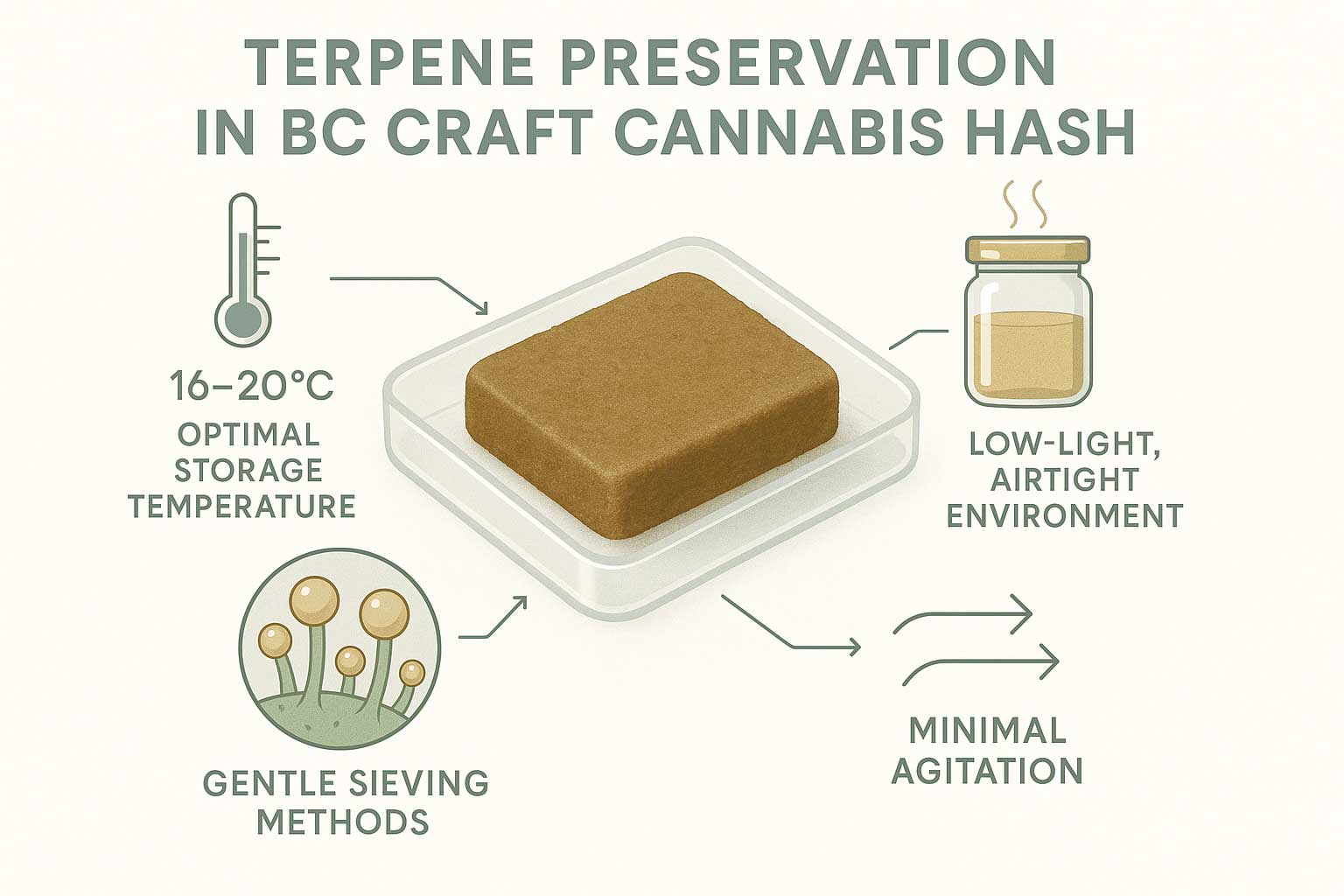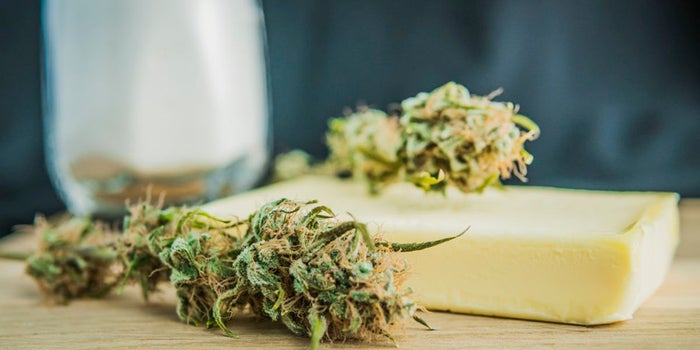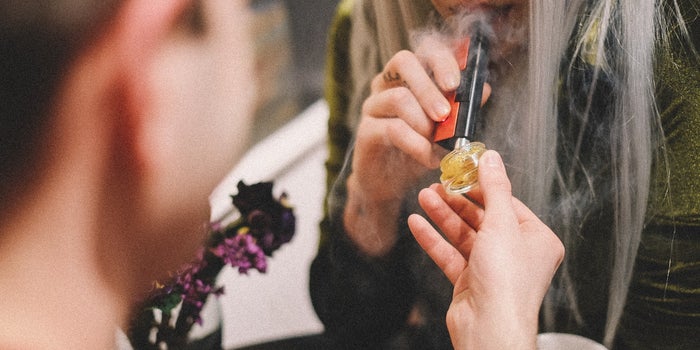Terpenes shape flavour, aroma, and a good part of how hash feels in the body. Keeping those delicate compounds intact depends on choices made from harvest to packaging, and later in how consumers store and serve their concentrate. Kootenay Botanicals works with BC craft producers who value quality, careful handling, steady temperatures, and minimal oxygen and light, so the finished resin stays true to the cultivar. Terpene retention in cannabis hash begins with timely harvests when trichome heads are mature, followed by a cold chain that limits evaporation and oxidation.
Gentle separation methods, whether dry sift with short, measured motions or ice-water washing with careful agitation, protect intact resin heads and reduce bruising. Thorough, low-temperature drying and prompt, light-safe packaging help preserve bright top notes that define strain character. After purchase, airtight storage away from heat, brief jar openings, clean tools, and moderate serving temperatures continue the work. Taken together, these small decisions keep flavour vivid, mouthfeel smooth, and the overall experience closer to the plant’s original profile.
Why Terpene Retention Matters in BC Craft Hash
Cannabis terpenes are volatile. Heat, oxygen, and light can strip them quickly, which flattens both scent and taste. When growers and makers in the Kootenays prioritize cool handling and gentle motion, the finished hash captures more of the plant’s original terpene profile and presents a clear link between cultivar and experience. Consumers notice this as a brighter nose on warm up, a cleaner, more layered taste on the first draw, and effects that feel true to the flower rather than muddied by harsh processing. The region’s craft focus supports these outcomes, since batches are smaller, protocols are tighter, and the goal is expression rather than volume.

The Main Risks to Terpenes and How to Control Them
Most terpene content loss comes from excessive heat, prolonged exposure to air, unnecessary agitation, and UV. Keeping temperatures low during and after separation helps prevent evaporation of lighter compounds. Limiting air contact during drying and pressing reduces oxidation, which otherwise dulls citrus, floral, and spice notes. Working with a calm, measured process for sifting or washing reduces friction, which can bruise trichomes and smear resin. Packaging that blocks light and seals well slows breakdown between the maker’s bench and your session. Each of these controls is simple on its own, and together they protect the character that gives Craft Hash its point of view.
Production Techniques That Preserve Terpenes
Gentle dry sift begins with cured material screened in short, controlled motions. Makers manage humidity and pace, then grade multiple times to isolate clean heads. Because friction and heat stay low, the result can taste precise and strain-true when pressed lightly into a cohesive piece. Clean sift that has been dried and stored in cool conditions tends to hold onto bright top notes and a smooth, tidy melt.
Ice-water bubble hash relies on cold water and careful agitation to separate trichomes without introducing heat. The wash passes through micron bags that sort heads by size, and the collected resin is dried thoroughly in a cool environment. A consistent cold chain from harvest to the final press minimizes terpene loss and supports a rounded, nuanced flavour once the hash meets gentle heat in a vaporizer or on a temperature-controlled surface. Makers who keep oxygen and light contact to a minimum during drying and packaging see better retention and a more expressive nose in the jar.
Across both methods, producers aligned with Kootenay Botanicals lean on cooler rooms, shorter press times, and sealed storage to preserve terpenes. This protects the bouquet of each cultivar, whether the target is a delicate, citrus-forward sift or a plush, creamy bubble that shows depth at moderate temperatures.
Handling and Storage That Keep the Flavour Intact after Purchase
Once a jar is in your hands, small habits keep terpenes present. Store hash in an airtight container away from light and heat. For longer holds, slightly cooler conditions are helpful, but let the piece warm to room temperature before opening to avoid condensation. Open the container briefly when serving to limit oxygen exposure, then reseal right away. Clean tools and surfaces so residue does not add off-notes. When heating, aim for modest temperatures and steady airflow. Gentle ramps protect top notes and keep the mouthfeel smooth, whether you favour a concentrate-ready vaporizer or a low-temperature surface. These steps match the care taken by BC craft producers and keep the experience consistent from the first serving to the last.
Choosing Producers and Batches with Terpene Retention in Mind
Look for transparent makers who share cultivar, method, drying approach, and storage guidance. Notes about cold handling, quick and thorough drying for bubble hash, and conservative pressing are all signals that a producer wants to preserve terpene. Seek packaging that blocks light and seals firmly, along with batch dates that align with careful throughput rather than long shelf stints. Kootenay Botanicals curates small-batch options that follow these standards, so you can compare aroma, texture, and melt across methods and pick based on taste rather than marketing claims. This aligns with the site’s craft-first stance and gives you confidence that what you smell and taste reflects intentional work at every stage.
Terpene retention in cannabis hash starts with cool, gentle production and ends with thoughtful storage and serving of the final product. Control heat, oxygen, light, and friction, choose batches from producers who document their process, and keep your own handling tidy and precise. The payoff is a fuller spectrum of flavour and a nose that announces the cultivar before the first draw.
With Kootenay Botanicals’ craft selection and clear product notes, it is easy to find resin that reflects the plant rather than the process, and to keep that character vivid from jar to session.



